Abstract
OBJECTIVES: Colorectal cancer (CRC) has the second highest cancer-related mortality rate in the United States. However, CRC screening rates, particularly by endoscopy, are dismally low. The purpose of this study is to determine the factors associated with adherence to endoscopic screening using the emergency department (ED) population. METHODS: Structured interviews in English or Spanish were administered to 122 patients, aged > or =50 in the ED of an urban academic medical center. Questions focused on sociodemographic and medical factors, knowledge deficits and attitudes towards screening as well as psychosocial factors that may be associated with screening adherence. Compliance with current screening guidelines was measured by self-report. RESULTS: The population was sociodemographically diverse. There were significant differences across ethnic groups with regards to awareness and attitudes toward screening as well participation in screening. Age >65, Spanish language during the interview, white ethnicity and having a primary care physician were significant correlates of adherence to screening colonoscopy. Once decisional balance (conspros) was entered into the model, the other factors were no longer significant. Furthermore, physician referral was the strongest correlate of adherence to endoscopic screening. CONCLUSIONS: There are significant sociodemographic, medical and psychosocial barriers preventing CRC screening adherence in ED patients, yet the strongest correlate is physician referral. The ED encounter may serve as an opportunity to provide information and referral for CRC screening.
Full text
PDF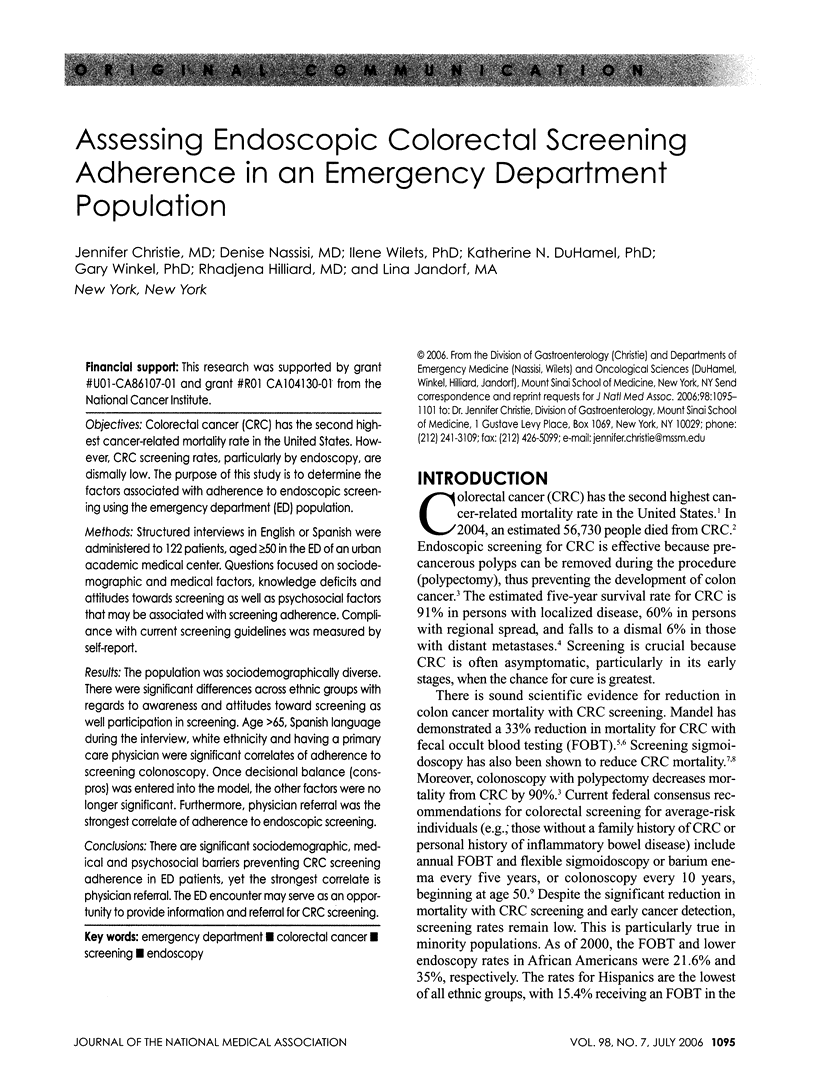

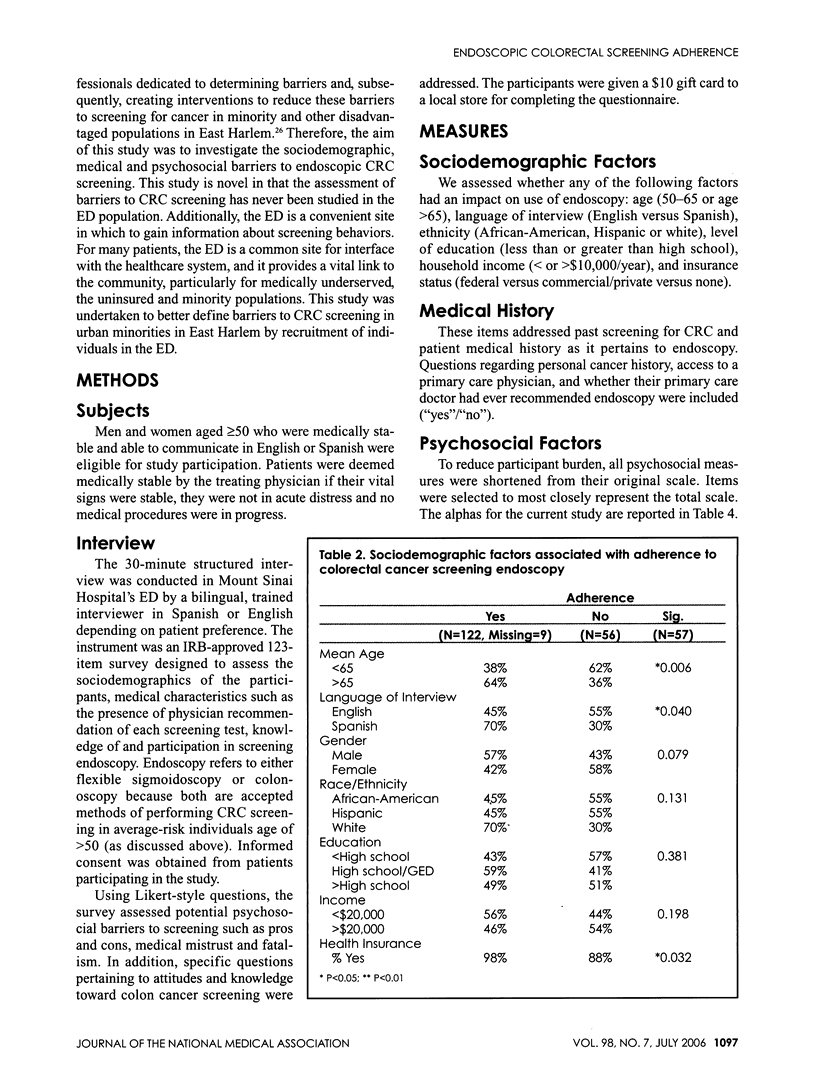
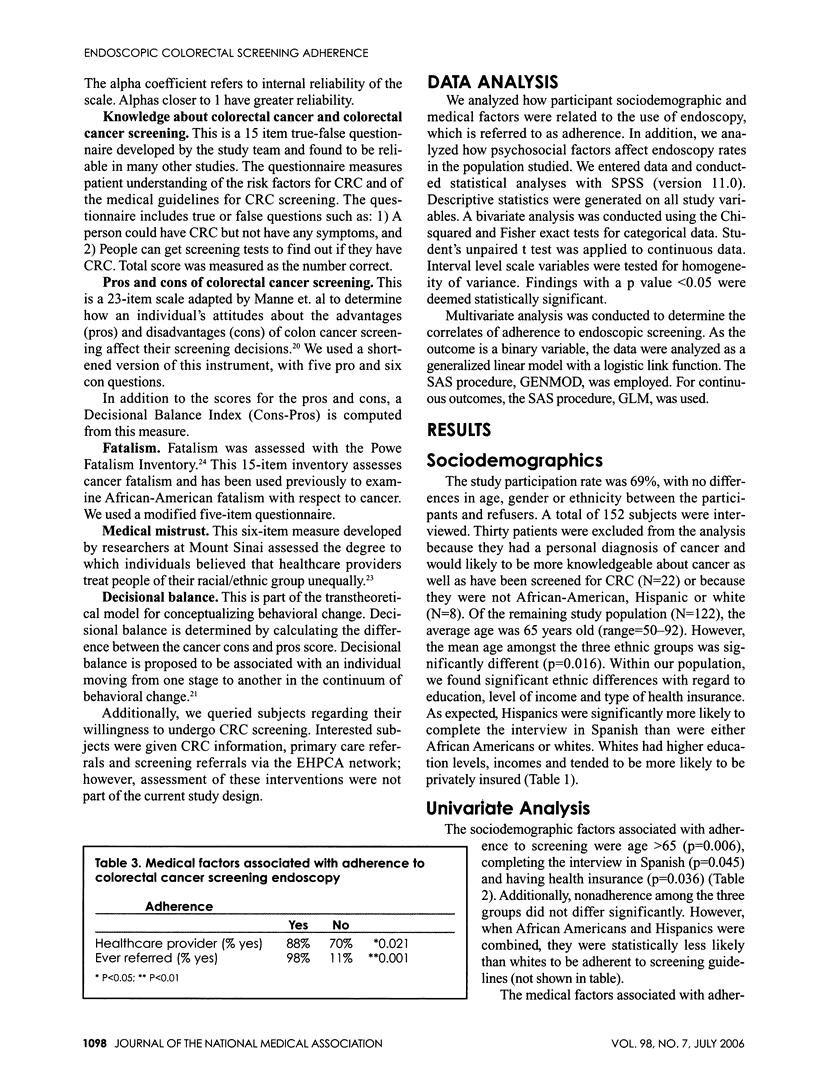

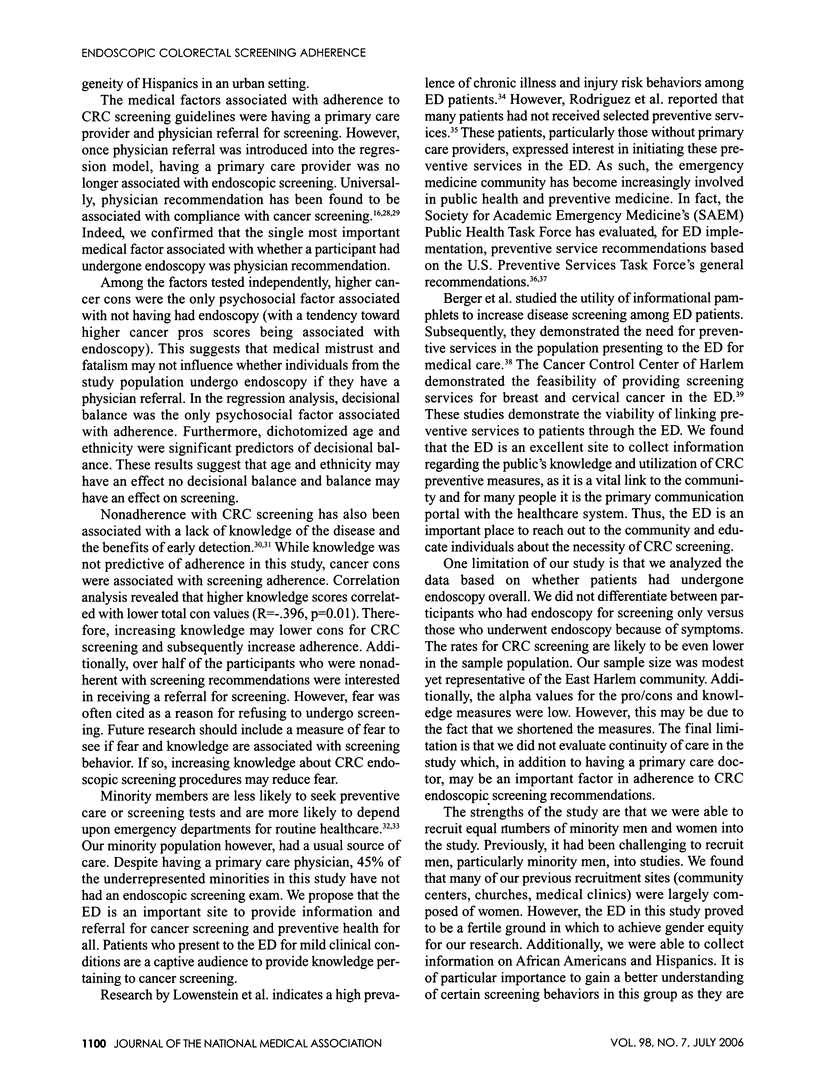
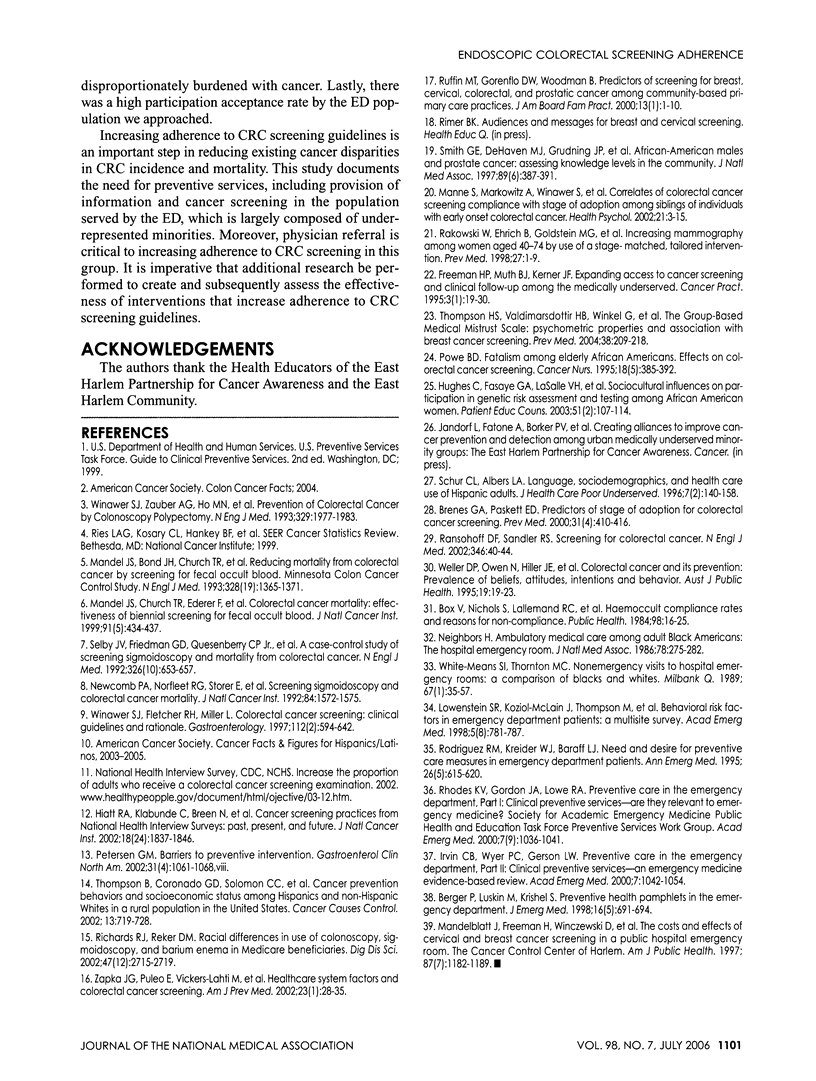
Selected References
These references are in PubMed. This may not be the complete list of references from this article.
- Babcock Irvin C., Wyer P. C., Gerson L. W. Preventive care in the emergency department, Part II: Clinical preventive services--an emergency medicine evidence-based review. Society for Academic Emergency Medicine Public Health and Education Task Force Preventive Services Work Group. Acad Emerg Med. 2000 Sep;7(9):1042–1054. doi: 10.1111/j.1553-2712.2000.tb02098.x. [DOI] [PubMed] [Google Scholar]
- Berger P., Luskin M., Krishel S. Preventive health pamphlets in the emergency department. J Emerg Med. 1998 Sep-Oct;16(5):691–694. doi: 10.1016/s0736-4679(98)00079-1. [DOI] [PubMed] [Google Scholar]
- Box V., Nichols S., Lallemand R. C., Pearson P., Vakil P. A. Haemoccult compliance rates and reasons for non-compliance. Public Health. 1984 Jan;98(1):16–25. doi: 10.1016/s0033-3506(84)80055-4. [DOI] [PubMed] [Google Scholar]
- Brenes G. A., Paskett E. D. Predictors of stage of adoption for colorectal cancer screening. Prev Med. 2000 Oct;31(4):410–416. doi: 10.1006/pmed.2000.0729. [DOI] [PubMed] [Google Scholar]
- Freeman H. P., Muth B. J., Kerner J. F. Expanding access to cancer screening and clinical follow-up among the medically underserved. Cancer Pract. 1995 Jan-Feb;3(1):19–30. [PubMed] [Google Scholar]
- Hiatt Robert A., Klabunde Carrie, Breen Nancy, Swan Judith, Ballard-Barbash Rachel. Cancer screening practices from National Health Interview Surveys: past, present, and future. J Natl Cancer Inst. 2002 Dec 18;94(24):1837–1846. doi: 10.1093/jnci/94.24.1837. [DOI] [PubMed] [Google Scholar]
- Hughes Chanita, Fasaye Grace Ann, LaSalle V. Holland, Finch Clinton. Sociocultural influences on participation in genetic risk assessment and testing among African American women. Patient Educ Couns. 2003 Oct;51(2):107–114. doi: 10.1016/s0738-3991(02)00179-9. [DOI] [PubMed] [Google Scholar]
- Lowenstein S. R., Koziol-McLain J., Thompson M., Bernstein E., Greenberg K., Gerson L. W., Buczynsky P., Blanda M. Behavioral risk factors in emergency department patients: a multisite survey. Acad Emerg Med. 1998 Aug;5(8):781–787. doi: 10.1111/j.1553-2712.1998.tb02504.x. [DOI] [PubMed] [Google Scholar]
- Mandel J. S., Bond J. H., Church T. R., Snover D. C., Bradley G. M., Schuman L. M., Ederer F. Reducing mortality from colorectal cancer by screening for fecal occult blood. Minnesota Colon Cancer Control Study. N Engl J Med. 1993 May 13;328(19):1365–1371. doi: 10.1056/NEJM199305133281901. [DOI] [PubMed] [Google Scholar]
- Mandel J. S., Church T. R., Ederer F., Bond J. H. Colorectal cancer mortality: effectiveness of biennial screening for fecal occult blood. J Natl Cancer Inst. 1999 Mar 3;91(5):434–437. doi: 10.1093/jnci/91.5.434. [DOI] [PubMed] [Google Scholar]
- Mandelblatt J., Freeman H., Winczewski D., Cagney K., Williams S., Trowers R., Tang J., Gold K., Lin T. H., Kerner J. The costs and effects of cervical and breast cancer screening in a public hospital emergency room. The Cancer Control Center of Harlem. Am J Public Health. 1997 Jul;87(7):1182–1189. doi: 10.2105/ajph.87.7.1182. [DOI] [PMC free article] [PubMed] [Google Scholar]
- Manne Sharon, Markowitz Arnold, Winawer Sidney, Meropol Neal J., Haller Daniel, Rakowski William, Babb James, Jandorf Lina. Correlates of colorectal cancer screening compliance and stage of adoption among siblings of individuals with early onset colorectal cancer. Health Psychol. 2002 Jan;21(1):3–15. [PubMed] [Google Scholar]
- Neighbors H. W. Ambulatory medical care among adult black Americans: the hospital emergency room. J Natl Med Assoc. 1986 Apr;78(4):275–282. [PMC free article] [PubMed] [Google Scholar]
- Newcomb P. A., Norfleet R. G., Storer B. E., Surawicz T. S., Marcus P. M. Screening sigmoidoscopy and colorectal cancer mortality. J Natl Cancer Inst. 1992 Oct 21;84(20):1572–1575. doi: 10.1093/jnci/84.20.1572. [DOI] [PubMed] [Google Scholar]
- Petersen Gloria M. Barriers to preventive intervention. Gastroenterol Clin North Am. 2002 Dec;31(4):1061-8, viii. doi: 10.1016/s0889-8553(02)00052-3. [DOI] [PubMed] [Google Scholar]
- Powe B. D. Fatalism among elderly African Americans. Effects on colorectal cancer screening. Cancer Nurs. 1995 Oct;18(5):385–392. [PubMed] [Google Scholar]
- Ransohoff David F., Sandler Robert S. Clinical practice. Screening for colorectal cancer. N Engl J Med. 2002 Jan 3;346(1):40–44. doi: 10.1056/NEJMcp010886. [DOI] [PubMed] [Google Scholar]
- Rhodes K. V., Gordon J. A., Lowe R. A. Preventive care in the emergency department, Part I: Clinical preventive services--are they relevant to emergency medicine? Society for Academic Emergency Medicine Public Health and Education Task Force Preventive Services Work Group. Acad Emerg Med. 2000 Sep;7(9):1036–1041. doi: 10.1111/j.1553-2712.2000.tb02097.x. [DOI] [PubMed] [Google Scholar]
- Ruffin M. T., Gorenflo D. W., Woodman B. Predictors of screening for breast, cervical, colorectal, and prostatic cancer among community-based primary care practices. J Am Board Fam Pract. 2000 Jan-Feb;13(1):1–10. doi: 10.3122/jabfm.13.1.1. [DOI] [PubMed] [Google Scholar]
- Schur C. L., Albers L. A. Language, sociodemographics, and health care use of Hispanic adults. J Health Care Poor Underserved. 1996 May;7(2):140–158. doi: 10.1353/hpu.2010.0024. [DOI] [PubMed] [Google Scholar]
- Selby J. V., Friedman G. D., Quesenberry C. P., Jr, Weiss N. S. A case-control study of screening sigmoidoscopy and mortality from colorectal cancer. N Engl J Med. 1992 Mar 5;326(10):653–657. doi: 10.1056/NEJM199203053261001. [DOI] [PubMed] [Google Scholar]
- Smith G. E., DeHaven M. J., Grundig J. P., Wilson G. R. African-American males and prostate cancer: assessing knowledge levels in the community. J Natl Med Assoc. 1997 Jun;89(6):387–391. [PMC free article] [PubMed] [Google Scholar]
- Thompson Beti, Coronado Gloria D., Solomon Cam C., McClerran Dale F., Neuhouser Marian L., Feng Ziding. Cancer prevention behaviors and socioeconomic status among Hispanics and non-Hispanic whites in a rural population in the United States. Cancer Causes Control. 2002 Oct;13(8):719–728. doi: 10.1023/a:1020280427712. [DOI] [PubMed] [Google Scholar]
- Thompson Hayley S., Valdimarsdottir Heiddis B., Winkel Gary, Jandorf Lina, Redd William. The Group-Based Medical Mistrust Scale: psychometric properties and association with breast cancer screening. Prev Med. 2004 Feb;38(2):209–218. doi: 10.1016/j.ypmed.2003.09.041. [DOI] [PubMed] [Google Scholar]
- Weller D. P., Owen N., Hiller J. E., Willson K., Wilson D. Colorectal cancer and its prevention: prevalence of beliefs, attitudes, intentions and behaviour. Aust J Public Health. 1995 Feb;19(1):19–23. doi: 10.1111/j.1753-6405.1995.tb00291.x. [DOI] [PubMed] [Google Scholar]
- White-Means S. I., Thornton M. C. Nonemergency visits to hospital emergency rooms: a comparison of blacks and whites. Milbank Q. 1989;67(1):35–57. [PubMed] [Google Scholar]
- Winawer S. J., Zauber A. G., Ho M. N., O'Brien M. J., Gottlieb L. S., Sternberg S. S., Waye J. D., Schapiro M., Bond J. H., Panish J. F. Prevention of colorectal cancer by colonoscopic polypectomy. The National Polyp Study Workgroup. N Engl J Med. 1993 Dec 30;329(27):1977–1981. doi: 10.1056/NEJM199312303292701. [DOI] [PubMed] [Google Scholar]
- Yusuf H. R., Giles W. H., Croft J. B., Anda R. F., Casper M. L. Impact of multiple risk factor profiles on determining cardiovascular disease risk. Prev Med. 1998 Jan-Feb;27(1):1–9. doi: 10.1006/pmed.1997.0268. [DOI] [PubMed] [Google Scholar]
- Zapka Jane G., Puleo Elaine, Vickers-Lahti Maureen, Luckmann Roger. Healthcare system factors and colorectal cancer screening. Am J Prev Med. 2002 Jul;23(1):28–35. doi: 10.1016/s0749-3797(02)00444-0. [DOI] [PubMed] [Google Scholar]


